
Weed It & Reap: North Toledo peace garden
Community source of pride grows over scars
9/3/2014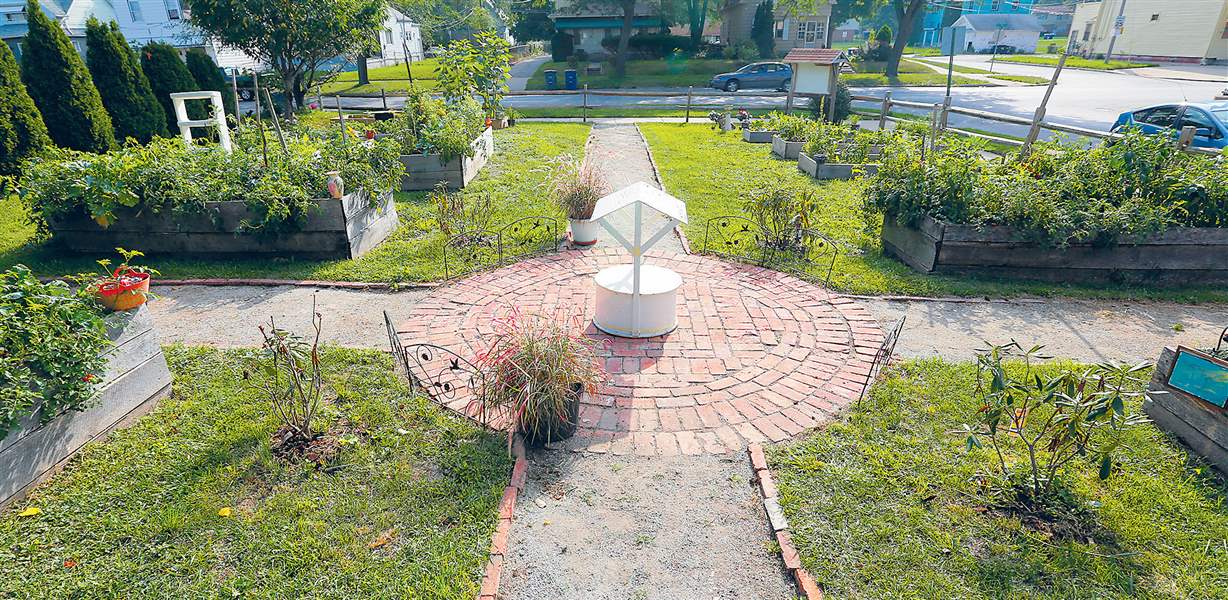
All are invited to sow and to reap in the garden at Stickney and Bronson avenues.
THE BLADE/ANDY MORRISON
Buy This Image

All are invited to sow and to reap in the garden at Stickney and Bronson avenues.
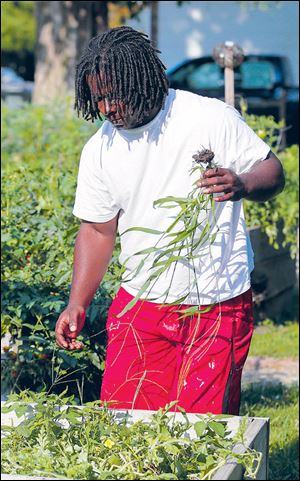
Derek Hawkins weeds a planting box.
The Stickney/Bronson community garden grew out of fury and violence.
A neo-Nazi group said they’d march through North Toledo on Oct. 15, 2005. At the eleventh hour, Toledo police sent them packing, but it was too late. Six-hundred people had gathered and many were ready to fight, if not the neo-Nazis then the police.
It would be the worst violence in Toledo since the 1960s race riots. A convenience store and a bar were robbed and trashed, the bar was set ablaze. A dozen police were injured and more than 120, including 34 juveniles, were arrested. Taxpayer cost was tallied at more than $336,000.
PHOTO GALLERY: Peace Garden
Response was swift on many fronts. Few wanted the youngsters, who included a couple of girls, to be thrown in jail, burdened with court costs, and end up with diminished futures because of having a record.
Community and church leaders along with city and court employees devised an alternative: If the teens and their parents attended a six-session course in which they’d be taught how to protest and make change peacefully, followed by 25 hours of community service by the teens, the costs and their record would be forgiven. Moreover, they’d be offered a job.
The city let them turn a big neighborhood lot into a garden with the help of Toledo Grows and the juvenile court’s employment training program, called CITE.
Seven teens signed on to build the peace garden in exchange for wages and planned it with a landscape architect, and by Spring, 2007, it was ready to go.
They collected debris, enough to fill a dump truck. They spread six truckloads of good dirt, planted a row of shrubs and flowers, and built raised beds, a brick walkway, and a tool shed.
In subsequent years, Toledo Grows/CITE kept the garden going, trying over and again to get neighbors interested enough to help out, said Charlie Johnson, CITE program manager. But it’s always an uphill slog. People would stop by to pick produce, but it wasn’t until 2010, when Christie Davis showed up, that the garden flourished.
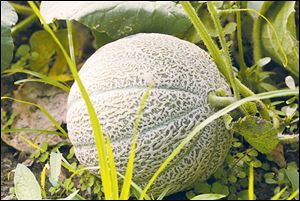
Cantaloupe grown in the garden.
Davis learned as she went. She welcomed people who offered to lend a hand and gave vegetables to passersby and the food pantry at Wesley United Methodist Church across the street.
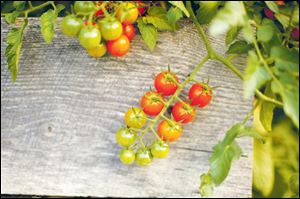
Cherry tomatoes spill out of a planting box.
“It’s a wonderful way to beautify the neighborhood. It’s very beneficial,” said the church’s Pastor Waverly Earley, who helps the garden with money, cookies, and a place for meetings.
Petite and attractive, Davis puts on her face, including fake eyelashes, before leaving home. “The kids like to look me in the face and say ‘You’re pretty.’ ”
Last year, the garden got away from her. Early on, she got sunburned so badly, she became ill and went to the hospital. One day in the garden, she was bit twice by a spider on the shin. It became so swollen it had to be lanced and drained, laying her up for a while.
“This summer I’ve been watching out for everything,” she said.
Students from nearby Woodward High School came out last spring and helped with clean. And children from a day-camp program at Spring School down the street planted veggies and will be back to pick them in October.
The Stickney/Bronson Community Garden is one of four that Toledo Grows/CITE provides additional support such as filling the 250-gallon water lug, mowing the grass, edging, bringing new soil, mulch, and free plants and seeds.
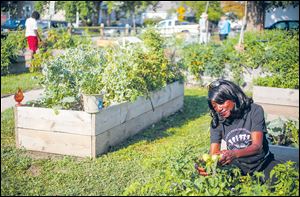
Christie Davis provides both hands and heart for this garden.
Garden specs: 200-by-100-feet, surrounded by a split-rail fence.
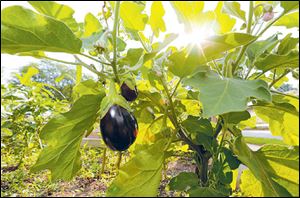
Eggplant grows in the garden.
When did you start gardening? When I was about five, with my grandmother, Mattie Harris, in McKenzie, Tenn. in the mountains. She had a mule and plow and a big garden. She moved to Toledo in 1956 or ‘57. We had a garden and fed the birds every morning.
And when my daughter was little, she always wanted a garden so I planted tomatoes and kept expanding. After we moved to this neighborhood, I wanted something bigger. When I saw this garden I said, ‘I’m going to ask God if I can have a spot there,’ and He said ‘Yes. Take everything from your garden up there.’ I had a meeting with Allie Osmun [from Toledo Grows] and Charlie Johnson [CITE] at the library. That’s where I met all these people and they’ve helped me. I had a grandson in the CITE program and he worked with them.
What do you grow? Collards, okra, six types of tomatoes, turnip and mustard greens, summer squashes, melon. When vegetables are ripe I’ll leave them on the table and people come all day and at night and take them.
Favorite plant: Greens and corn. And I keep a flower garden here for my daughter, Rosemary Dockery, who was 26 when she was killed in a car accident in 2002.
Give us a tip: I know a group of men who fish and they give me the heads and guts and scales from blue gills and croppies [also called crappipes] and I freeze them and then bring them here, mix them with dirt for a day or so, turn them, and then put it in the soil.
Hours spent gardening per week? 40 hours. I’m here every day. Sometimes from 8:30 or 9 a.m. to midnight.
My cousin, Regina O’Neill, stays three doors down. She comes and weeds [she is an amazing weeder] and fixes me something to eat.
Annual expense: Whatever I need.
Challenges: The first year I went to a training class for community gardeners but then the teachers took a two-week vacation and I was clueless about what to do. Some things I planted in the wrong place. I knew more the second year and I got probably twice as much produce.
I had flowers, a bench, little fences, and bought lights and put them along the brick path in a cross pattern, but people took them, so I started getting a little discouraged about putting things in the garden. I can’t bring the picnic table from my house because they’ll take it.
And people [who help themselves to produce] don’t know how to pick collards. The trick is to pick from the bottom up and leave the top two-thirds of the leaves. I’ve learned to hide watermelon by getting the vines to cover the melon; that way, people don’t see it and steal it.

Pastor Waverly Earley, left, greets Charlie Johnson with a hug.
I’m proud of: “I’m proud being blessed to sow a seed. God brings it up and I see what He makes -- each plant is different. And I have a cookout every year for the boys [in the CITE program]. I cook on two grills and invite the whole neighborhood.
What do you get out of gardening: I enjoy helping people eat, whenever, however, where ever.
Garden Calendar: The Black Swamp Hosta and Daylily Society will meet at 1 p.m. Sept, 13 in the Conference Center at Toledo Botanical Garden, 5403 Elmer Dr. Following the business meeting, at 2 p.m., a speaker from North Branch Nursery will present a program on trees and shrubs, and what plants to look forward to in the future. The speaker will begin at 2 pm. Meetings are free and open to the public. Parking is free and use the main lot off Elmer Drive.
Contact Tahree Lane at: tlane@theblade.com or 419-724-6075.